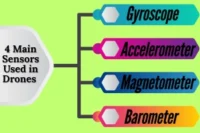Explore the Pros and Cons of Drone Frame Materials
Published: 17 Jul 2025
Imagine flying a drone that feels light as a feather but tough as steel. Sounds cool, right? That’s what the right frame material can do. A good frame doesn’t just hold the parts together. It decides how smooth your drone flies, how long it lasts, and how well it handles bumps or crashes. Whether you fly for fun, shoot videos, or use drones for farming, choosing the right frame makes a big difference. Carbon fiber is strong and super light. Plastic is cheap and easy to replace. Aluminium is durable but can add weight. Each material has pros and cons, and knowing them helps you pick the one that fits your flying style.
Drone Frame Materials
Your drone’s frame is more than just a body. It’s the skeleton that holds everything together. Pick the right material, and your drone flies smoother, crashes less, and lasts longer. Pick the wrong one, and you might end up with short flights, shaky videos, or broken parts after a small bump.
So, what’s the best frame material for you? That depends on how you fly and what you want your drone to do. Let’s look at the pros and cons of each frame material, carbon fiber, plastic, and aluminium.
Carbon Fiber
Carbon fiber is a high-end material made from thin carbon threads. It’s light, super strong, and great for high-performance drones.
| Pros |
|---|
|
| Cons |
|---|
|
Plastic (ABS/Nylon)
Plastic frames are made from durable synthetic materials like ABS or nylon. They’re affordable and great for beginners.
| Pros |
|---|
|
| Cons |
|---|
|
Aluminium
Aluminum is a metal used in many DIY and industrial drone builds. It offers a strong frame at a moderate price.
| Pros |
|---|
|
| Cons |
|---|
|
Common Mistakes to Avoid
Picking a drone frame is not just about grabbing the cheapest option or the coolest-looking one. Many beginners make small mistakes that lead to poor flight performance or quick damage. Here are some common slip-ups to watch out for and how to avoid them.
Choosing just based on price : Going for the cheapest frame might save money now, but it can cost more later. Cheap materials may crack, bend, or wear out fast leading to more repairs or full replacements.
Ignoring drone purpose (racing vs hobby) : Not all drones are made for the same job. A heavy frame won’t work well for racing, and a super-light one might not hold up for filming or carrying gear. Always match the frame to your flying needs.
Not checking weight with battery/camera : Many people forget to factor in the total weight. Your frame, battery, and camera must balance out. Too much weight means shorter flight time and more stress on motors.
Overlooking material reparability : Crashes happen. If your frame is hard to repair or needs full replacement, you’ll waste time and money. Some materials (like plastic or aluminum) are easier to fix than carbon fiber.
Conclusion
Your drone’s frame material plays a big role in how it flies, how long it lasts, and how much fun you have using it. There’s no perfect material for everyone, what works for racing won’t always work for filming or farming.
So take a moment. Think about how you use your drone. Match the frame to your flying style, and you’ll enjoy better performance, fewer crashes, and less money spent on repairs. Choose smart, and fly smooth





